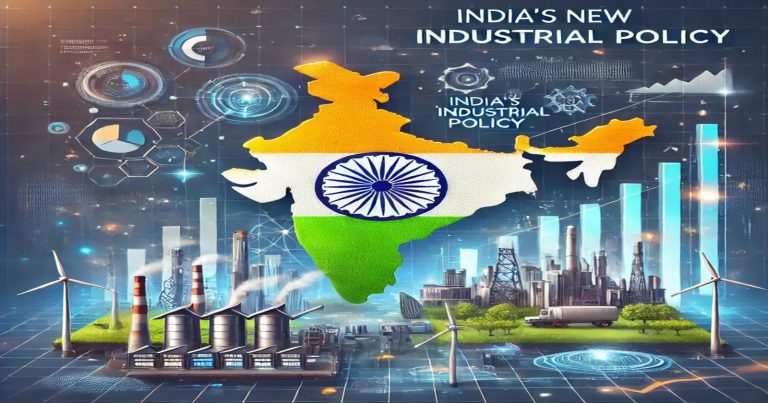The India new industrial policy is the backbone strategy to propel economic growth and modernize industries in the country for the challenges of a globalized world. It stresses innovation, increases manufacturing efficiency, and enhances investments in different sectors, which are the building blocks of shaping India’s future economic trajectory. This policy deals with some of the most important issues: innovation, employment, and sustainability, thus placing India at a critical juncture in the global economy. Its successful implementation depends upon overcoming the hurdles of infrastructure and regulation.
What is India New Industrial Policy?
India’s new industrial policy is a forward-looking framework aimed at revitalizing the nation’s industrial landscape. Unveiled by the government to adapt to global market dynamics and emerging technologies, this policy prioritizes sustainable development, job creation, and regional equity. It serves as a blueprint for industries to thrive in a rapidly changing global environment by embracing innovation, technology, and collaboration.
Key Features of India’s New Industrial Policy
India’s New Industrial Policy focuses on boosting innovation and sustainable growth. It aims to modernize industries, support startups, and create a skilled workforce for the future.
- Focus on Digital Transformation: The policy encourages industries to adopt AI, IoT, and blockchain technologies. It aims to make industries smarter and more efficient with modern tools.
- Sustainability Goals: It promotes green energy and eco-friendly production processes. The goal is to reduce pollution and save natural resources for the future.
- Investment Incentives: The policy offers tax breaks and subsidies for startups and MSMEs. These benefits help businesses grow and create more jobs.
- Skill Development: It emphasizes vocational training and skill upgrades for workers. The focus is on preparing the workforce for future job needs.
- Ease of Doing Business: The policy simplifies compliance and reduces regulatory hurdles. It makes starting and running a business quicker and easier.
Objectives of India New Industrial Policy
The policy’s objectives aim to make India a global manufacturing hub and promote inclusive growth. These objectives resonate with the need for new industrial policy in India UPSC aspirants and economists alike.
Primary Objectives
The new industrial policy focuses on driving economic growth through key objectives. It aims to strengthen manufacturing, boost exports, create jobs, and attract global investments.
- Boost Manufacturing: The policy aims to increase the sector’s contribution to GDP from 16% to 25% by 2030. It focuses on upgrading factories and using advanced technologies to improve production, making India a global manufacturing hub.
- Create Employment: It focuses on generating millions of skilled and unskilled jobs across regions. Special programs will train workers to meet industry needs, ensuring better livelihoods for families.
- Promote MSMEs: The policy facilitates the growth of micro, small, and medium enterprises as engines of innovation. It ensures easy access to loans and technology, helping small businesses scale up quickly.
- Enhance Exports: The policy plans to improve global competitiveness and strengthen trade relations. It supports industries in producing high-quality goods for the global market, aiming to increase India’s share in international trade.
- Encourage FDI: The policy attracts foreign direct investment with investor-friendly policies. It aims to build trust with global investors and make India a preferred destination for investments.
Secondary Goals
The new industrial policy focuses on modernizing industries and promoting inclusive growth. It aims to upgrade technology, develop industrial clusters, and ensure balanced development across all regions.
- Technological Upgradation: The policy supports R&D to foster indigenous innovation and reduce dependency on imports. It encourages industries to adopt advanced technologies for better productivity. This will help India compete globally with innovative products.
- Cluster Development: It promotes the development of industrial clusters to boost efficiency and reduce costs. These clusters will allow businesses to share resources and infrastructure. The goal is to make industries more competitive and sustainable.
- Balanced Regional Development: The policy focuses on industrial growth in backward and rural areas. It aims to create jobs and improve infrastructure in these regions. This will help reduce regional inequality and support inclusive growth.
Limitations of India New Industrial Policy
The new industrial policy identifies key challenges that hinder growth and competitiveness. It focuses on addressing infrastructure gaps, skill shortages, regulatory issues, and global competition while balancing development with sustainability.
Infrastructure Gaps
- Transport and Logistics: Inadequate transport and logistics facilities hinder industrial growth. Poor road networks and insufficient ports delay goods movement, increasing costs for industries.
- Electricity Access: Limited access to reliable electricity in rural areas disrupts industrial operations. Power outages and lack of infrastructure make it hard for businesses to function efficiently.
Skilled Workforce Shortage
- Training Programs: Lack of training programs aligned with industry needs creates a skills gap. Workers need better vocational courses to meet modern job requirements.
- Education-Industry Mismatch: A mismatch between educational outputs and market requirements limits job readiness. Industries struggle to find employees with relevant skills for specialized roles.
Regulatory Bottlenecks
- Bureaucratic Delays: Despite improvements, bureaucratic delays persist in many processes. Businesses waste time and resources dealing with lengthy approvals.
- Land Acquisition: Complex land acquisition processes deter investment. Industries face high costs and legal challenges when acquiring land for new projects.
Environmental Concerns
- Sustainability Conflict: Industrial activities may conflict with sustainable development goals. Factories often struggle to adopt green practices while staying profitable.
- Growth vs Ecology: Balancing growth with ecological preservation remains a challenge. Policymakers need better frameworks to protect the environment without slowing progress.
Global Competition
- Cheap Imports: Domestic industries struggle against cheap imports and global giants. Foreign goods often dominate markets, making it hard for local businesses to thrive.
- High Input Costs: High input costs reduce competitiveness for Indian industries. Expensive raw materials and outdated technologies further widen the gap with global players.
India New Industry Policy FAQs
What is the focus of India’s new industrial policy?
The policy focuses on digital transformation, sustainable development, and boosting manufacturing and exports.
Why is there a need for a new industrial policy in India UPSC?
A new industrial policy aligns India’s economic strategies with global trends and addresses modern challenges like technology integration and environmental sustainability.
How does the new industrial policy promote MSMEs?
It offers financial incentives, technological support, and easier access to credit to empower MSMEs.
What are the sustainability goals of the policy?
The policy encourages green manufacturing, renewable energy adoption, and eco-friendly practices to achieve sustainable development.
What are the challenges in implementing the new industrial policy of India?
Challenges include infrastructure inadequacies, skilled workforce shortages, regulatory complexities, and environmental considerations.


